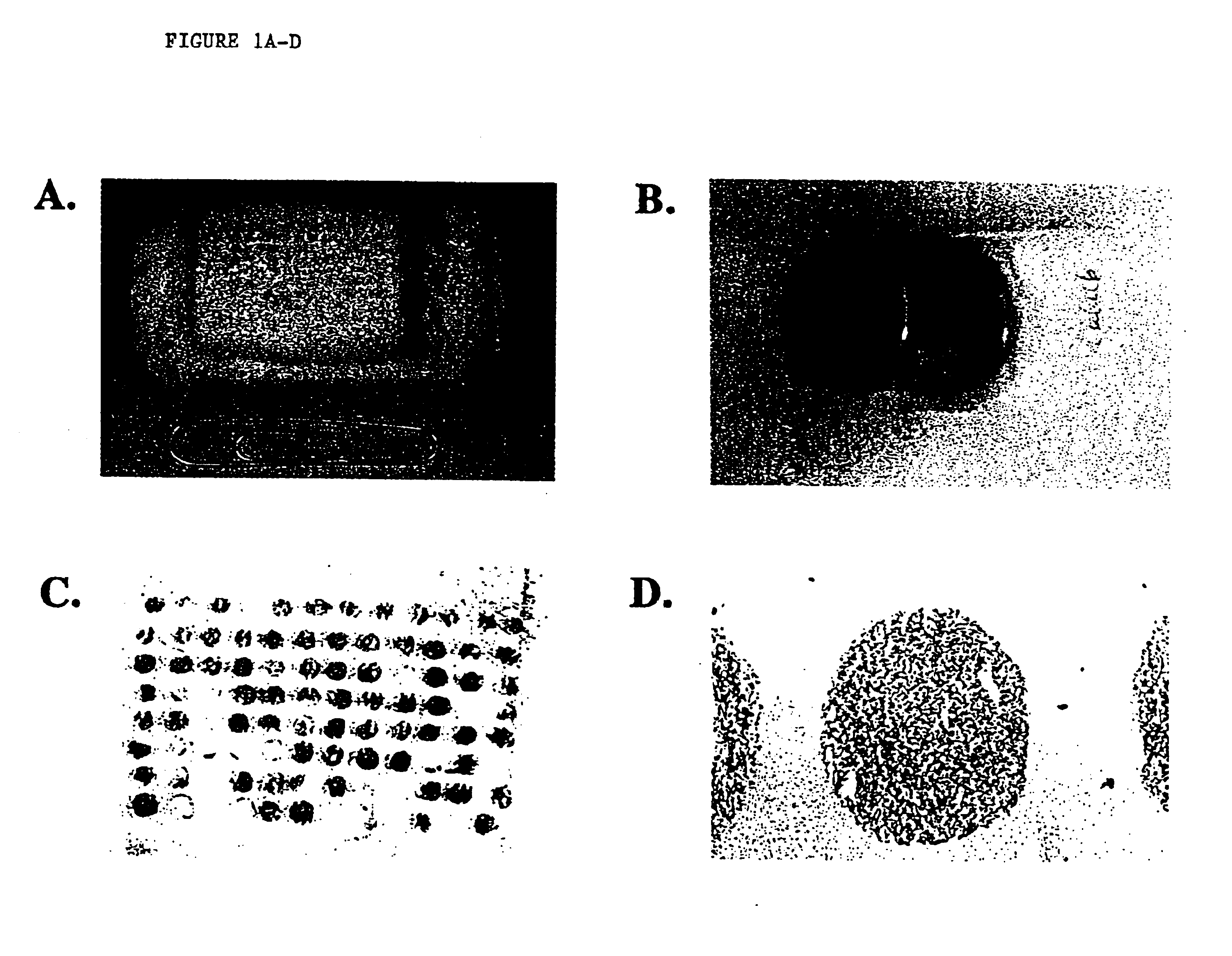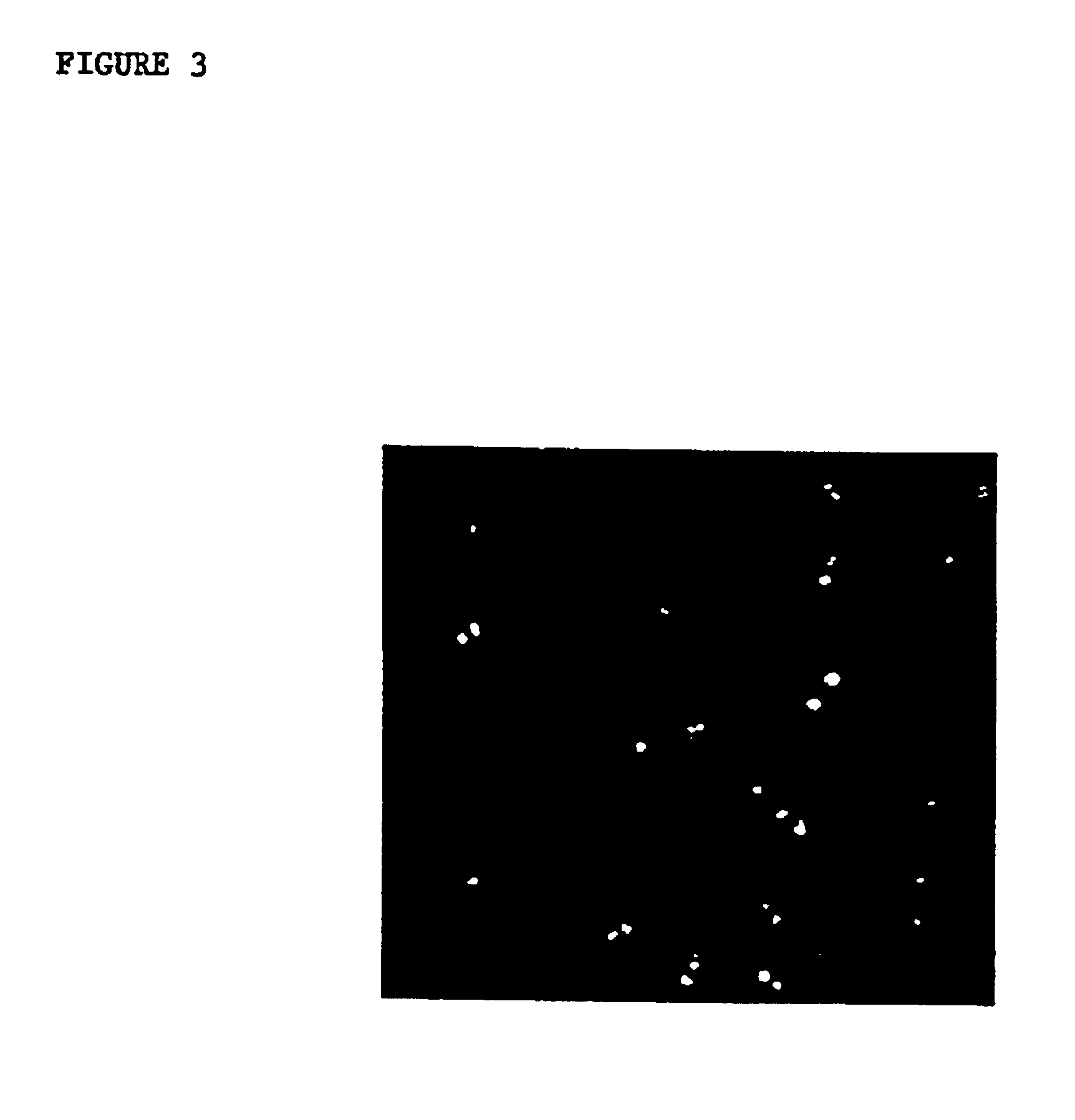Frozen tissue microarray technology for analysis RNA, DNA, and proteins
a tissue array and frozen technology, applied in the field of frozen tissue array technology, can solve the problems of insufficient array analysis of some proteins or rna using in situ hybridization, inability to prevent rna degradation, and inability to embed ethanol-fixed tissue paraffinly,
- Summary
- Abstract
- Description
- Claims
- Application Information
AI Technical Summary
Benefits of technology
Problems solved by technology
Method used
Image
Examples
example 1
Frozen Array Construction
[0042]A human lung cancer cell line CALU-6 grown as a mouse xenograft and human breast cancer cells MDA-MB-231 grown in vitro and pelleted were frozen and embedded in O.C.T. compound embedding medium (Miles Inc. Diagnostic Division, Elkhart, Ind.) to test whether arrays could be cored and collected in this medium. Methodology was as published previously (1), except that tissue biopsies (diameter 0.6 and 1.0 mm; height 3-4 mm) were punched from tumors in O.C.T. and placed directly into an O.C.T. array block using a tissue microarrayer (Beecher Instruments, Silver Spring, Md., USA).
[0043]The recipient O.C.T. array block was made by filling a Tissue-Tek standard cryomold (Miles Inc., Elkhart Ind.) with O.C.T. and mounting the O.C.T. filled mold to the base of a plastic biopsy cassette (Simport Histosette II Biopsy Cassette from Fisher Scientific with lid removed), see FIG. 1A. The recipient O.C.T. block has the same size base as the paraffin recipient block tha...
example 2
Non radioactive RNA In Situ Hybridization Methods Employing Frozen Arrays
[0046]Nonradioactive RNA in situ hybridization was performed as published previously for frozen sections (see, e.g. Hogan et al. Manipulating the Mouse Embryo: A Laboratory Manual. New York: Cold Spring Harbor Laboratory Press (1994). Briefly, tissue array sections used for RNA in situ hybridization were fixed in 4% paraformaldehyde in phosphate buffered saline (PBS) for either 10 minutes, 2 hours, or overnight at 4 C. Slides were rinsed 3 times in PBS for 5 minutes each and drained. Sections were covered with a prehybridization buffer (50% deionized formamide, 5×SSC, 5× Denhardt's, 750 ug / ml torula RNA) and placed in a humid chamber at room temperature for 2 hours. Hybridization was performed by adding 0.5 micrograms of digoxigenenin-labeled actin RNA probe (Boehringer Mannheim, Germany) to 10 ml of prehybridization solution in a 5-slide mailer. Tissue nucleic acid was denatured at 85 C for 10 minutes and cool...
example 3
Fluorescent In Situ Hybridization Methods Employing Frozen Arrays
[0048]Frozen tissue microarray sections were fixed in Carnoy's fixative or 95% ethanol for 10 minutes. Slides were pretreated in 2×SSC at 37 C for 30 minutes, dehydrated, denatured in 70% formamide / 2×SSC for 5 minutes at 72 C, and dehydrated again. Slides were then treated either with or without 0.4 ug / ml proteinase K (Sigma, St. Louis, Mo., USA) at 37 C for 30 minutes. A spectrum orange chromosome 8 probe (Vysis Inc., Downer's Grove, Ill.) was prepared according to the manufacturer's instructions, denatured for 7 minutes at 72 C, and hybridized to the array slides overnight at 37 C in a humid chamber. Slides were washed (50% formamide / 2×SSC 44 C, 15 minutes; 2×SSC, 8 minutes) and counterstained with DAPI (Vysis, Downersgrove, Ill., USA). Slides were visualized using standard fluorescent microscopy and photographed with Ektachrome 400 ASA slide film (Eastman Kodak, Rochester, N.Y., USA).
[0049]Typical results of such an...
PUM
 Login to View More
Login to View More Abstract
Description
Claims
Application Information
 Login to View More
Login to View More - R&D
- Intellectual Property
- Life Sciences
- Materials
- Tech Scout
- Unparalleled Data Quality
- Higher Quality Content
- 60% Fewer Hallucinations
Browse by: Latest US Patents, China's latest patents, Technical Efficacy Thesaurus, Application Domain, Technology Topic, Popular Technical Reports.
© 2025 PatSnap. All rights reserved.Legal|Privacy policy|Modern Slavery Act Transparency Statement|Sitemap|About US| Contact US: help@patsnap.com



